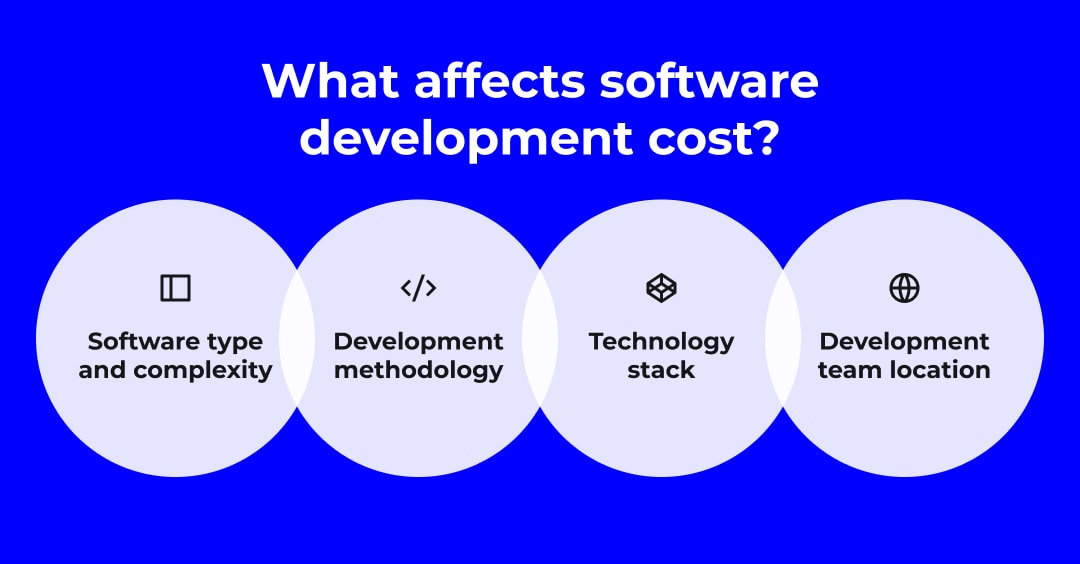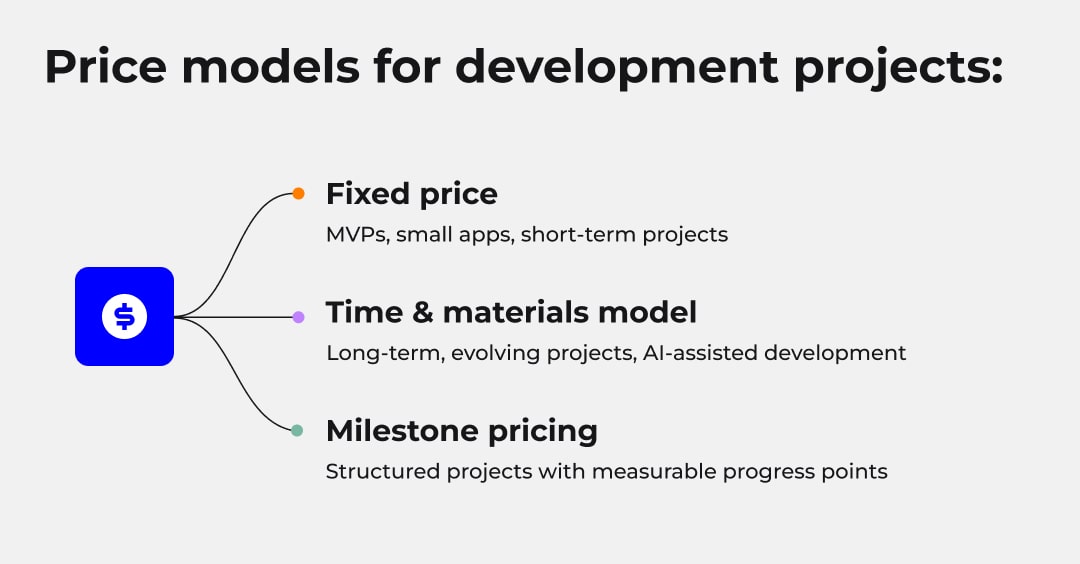Software development contains more than just writing the code. It also includes solving problems and tasks, as well as delivering seamless user experiences. But how much will it cost you to build software? It depends.
A simple app won’t cost the same as an AI-driven platform. Factors like project scope, team structure, and technology stack all play a role. With AI-assisted coding and global developer hiring reshaping the industry, pricing models have become more flexible.
Let’s break down what actually drives software development costs so you can plan your budget wisely.
Factors Affecting Costs of Software Development

Several factors impact software development costs, from project scope to technology choices. Knowing what drives these expenses helps you plan efficiently and avoid overspending.
Worried about unexpected development costs? Get expert insights on optimizing your software budget without compromising quality.
Consult with us todaySoftware Type and Complexity
The more advanced the features, the greater the cost. A basic application with limited functionality is far cheaper to develop than a multi-layered system requiring complex integrations, real-time data processing, and high-security measures.
For example, a calculator app takes minimal development effort. In comparison, an ERP system involves multiple interconnected components, user roles, and ongoing maintenance, driving up both time and costs.
If you're working on a straightforward tool, no-code or low-code platforms can speed up development and reduce expenses. However, if scalability and customization are priorities, a traditional development approach is often the better long-term investment.
Costs also depend on platform requirements. Building for web, iOS, Android, and desktop demands additional effort, increasing both development time and budget.
Development Methodology
Your choice of development methodology directly impacts software development costs, efficiency, and flexibility. The right approach helps streamline workflows, reduce unnecessary expenses, and avoid costly rework. With advancements in AI, automation, and cloud-based development, some methodologies now significantly lower software development costs compared to traditional approaches.
Waterfall
A step-by-step approach where each phase (planning, design, coding, testing, deployment) must be completed before moving to the next. Best for short, well-defined projects where requirements won’t change. However, any mid-development adjustments can be costly and time-consuming. This is why many teams now favor Agile or AI-powered automation for cost control.
Agile
Agile breaks development into iterative sprints, allowing frequent feedback and real-time adjustments. It’s ideal for projects that evolve, but constant refinements and extended timelines can increase costs. AI-driven coding assistants and automated testing are now reducing Agile overhead, cutting the need for extensive QA teams while keeping development nimble.
Scrum
A structured Agile framework where teams work in time-boxed sprints, regularly reassessing priorities. Smaller teams and incremental releases help control costs, but daily standups and ongoing iterations add overhead. Many teams now integrate AI for sprint planning and automation to optimize workload distribution.
Kanban
Kanban focuses on visualizing tasks and reducing work-in-progress, making it effective for frequent updates and maintenance projects. It improves efficiency but requires disciplined prioritization to prevent bottlenecks. AI-powered workflow automation tools now enhance Kanban by optimizing task assignments without manual intervention.
Lean
Inspired by lean manufacturing, this method eliminates unnecessary steps and automates repetitive processes. Ideal for small teams on tight budgets, Lean reduces waste, but demands experienced engineers to maintain quality. No-code/low-code platforms are now an extension of Lean, cutting development costs by up to 60% for simpler applications.
DevOps
A mix of development and operations, DevOps automates deployment, monitoring, and updates—reducing maintenance costs and accelerating delivery. While it requires skilled DevOps engineers and infrastructure investment, serverless computing and cloud-native automation now eliminate the need for traditional backend maintenance, dramatically lowering costs.
The AI & Automation Shift
No-code/low-code platforms now replace traditional development for MVPs, while AI-driven debugging and testing cut QA expenses. As software development evolves, reducing costs is no longer about hiring fewer developers, but about using smarter technology.
Managing unexpected software costs is like diagnosing a medical issue—you need to find the root cause before it escalates. We implemented iterative reviews and financial feedback loops, reducing unanticipated expenses by 20%. AI-driven cost monitoring has been a game-changer, allowing real-time budget adjustments that prevent overruns before they happen.
Technology Stack: Balancing Cost, Scalability, and Future Growth
Your technology stack directly influences development expenses, from hiring costs to long-term maintenance. The right choices keep your project scalable and cost-efficient, while the wrong ones lead to overpriced talent, maintenance issues, and expensive migrations.
Skill level & Software developer cost
The cost of hiring a software developers depends on the stack. Widely used languages like JavaScript, Python, and Java have a larger talent pool, keeping salaries competitive. Niche technologies, such as Rust or Solidity, drive up hiring costs due to fewer specialists.
AI-generated code is automating repetitive tasks, reducing development hours. But skilled engineers are still needed to refine, optimize, and manage AI-assisted coding, making high-level expertise more expensive.
For cross-platform projects, mobile app developers costs fluctuate depending on whether you build natively (Swift, Kotlin) or opt for a hybrid approach (React Native, Flutter)
Development speed & Cost optimization
Some stacks allow for faster deployment, while others require customization that slows progress. Serverless computing eliminates backend maintenance costs—you pay only for the computing power used. This pay-as-you-go model is a game-changer for cost optimization in software development.
According to McKinsey, embedding FinOps principles into software engineering processes can enhance cost efficiency by managing cloud expenses more proactively, ensuring that businesses optimize their infrastructure spending while maintaining development speed.
Scalability & Long-term viability
Scalability should consider keeping costs predictable. Some stacks scale horizontally (adding servers), others vertically (upgrading hardware). Cloud-native architectures with auto-scaling help you pay only for actual usage.
For security-focused applications, blockchain development adds new cost layers due to specialized talent needs. However, decentralized systems reduce reliance on costly centralized databases.
Meanwhile, quantum computing is still niche but is already reshaping encryption, data processing, and high-complexity applications. While expensive today, it may soon impact enterprise software costs.
Maintenance & Hidden costs
Every stack comes with hidden maintenance expenses. Some require constant updates (e.g., PHP-based systems), while others offer long-term stability with minimal patching. Choosing a low-maintenance stack reduces future technical debt.
AI-assisted debugging is now lowering testing costs, automating repetitive QA tasks, and catching bugs early, which means fewer costly post-release fixes.
A future-proof stack isn’t just about what works now—it’s about cutting costs and reducing risks over time.
Development Team Location
Where you hire affects the cost of software development. Local teams offer easier collaboration but come at a premium, while outsourcing to Eastern Europe, Latin America, or Southeast Asia can cut costs by 30–50%.
To minimize cost-per-hire in tech, many companies use a hybrid model, combining local leads with offshore developers. This balances expertise, cost efficiency, and flexibility without sacrificing quality. If you need fast scaling, outstaffing providers offer pre-vetted talent on flexible contracts, avoiding full-time hiring expenses.
Pricing models for development projects

Your pricing model shapes project flexibility, risk, and cost control. Whether you're working with an in-house team or outsourcing, the right approach can reduce software development costs while keeping projects on track.
Need a cost-effective development strategy? We help tech companies scale efficiently with smart pricing models and dedicated teams.
Let’s build your teamFixed-Price Model: Predictability at a Cost
A fixed-price contract locks in costs upfront. This is ideal for well-defined projects with a clear scope, set deadlines, and minimal changes. However, any adjustments mid-project may require renegotiation.
While this model works well for traditional software development, rigid pricing structures often lead to inefficiencies. A hybrid model, where fixed pricing is used for core functionalities and flexible billing is applied for iterative enhancements, is becoming more practical.
Best for: MVPs, small apps, short-term projects with a fixed scope.
Time & Materials Model: Flexibility with Less Cost Control
With this model, you pay for actual work done, usually containing an hourly rate plus materials. It’s perfect for projects with evolving requirements, allowing for flexibility and continuous improvements. However, without strong oversight, budgets can fluctuate. To optimize onboarding costs, set clear time tracking, budget caps, and progress reviews.
As AI-driven development and low-code platforms reduce manual coding time, this model is increasingly popular for fast-moving, AI-powered projects where new features are continuously refined. Still, it requires careful scope management to avoid escalating costs.
Best for: Long-term projects, AI-assisted development, evolving products.
Software costs can spiral out of control like tax season surprises, so I break development into two-week sprints with cost checkpoints. Last month, this helped us catch a potential $30,000 overrun when cloud usage exceeded estimates, allowing us to adjust before it became a real problem.
Milestone Pricing Model
Here, payments are tied to specific deliverables rather than time spent. You pay once a feature or stage is completed. This offers better visibility and motivation for timely delivery. This model can balance cost optimization in software development and project momentum but may slow down if milestones are too large or complex.
Today, milestone-based pricing is particularly effective for modular AI features, cloud-native applications, and serverless platforms. With the rise of AI-generated code, deliverables must be defined based on functionality rather than just time spent.
Best for: Structured projects with measurable progress points.
When you want to reduce software development costs, choose a model that supports agility, automation, and evolving tech needs.
Dedicated Team & Software Development Costs
A dedicated team model provides long-term, flexible development without the overhead of full-time hiring. Instead of maintaining a full in-house team, you pay only for the expertise you need, reducing costs while keeping full control over the project.
Scalability: Adjust team size based on project needs
Cost Savings: No full-time salaries or infrastructure costs
Project Control: Direct collaboration, aligned workflows
If you work on complex, evolving projects, a dedicated team ensures consistent quality and predictable costs, making it a cost-effective solution.
FAQ
What factors influence software development costs?
Software development costs depend on project complexity, tech stack, team location, and pricing model. High-skill expertise, AI integration, and advanced security features also drive up costs, while automation and efficient development methodologies help keep them in check.
How can I reduce software development costs without compromising quality?
Optimize team structure by leveraging dedicated or remote developers, use open-source tools, and adopt Agile for faster iterations. Automate testing, prioritize must-have features, and choose scalable infrastructure to avoid costly rewrites.
What are the best strategies for cost optimization in software development?
Invest in AI-assisted development, serverless infrastructure, and reusable code components. Use a hybrid team model, outsource selectively, and track expenses with cloud-based cost monitoring tools. Regular audits help eliminate waste and improve budget efficiency.
Ann Kuss is the CEO at Outstaff Your Team. After 11 years of expertise in building remote tech teams for startup unicorns and global tech brands, Ann decided to lead a new venture aiming to reinvent the way international tech teams scale. Throughout her career, Ann hired specialists for countless tech positions from more than 17 countries on all major continents. Ann graduated from Kyiv-Mohyla business school, is an MIM Kyiv alumna, and regularly takes part in mentorship programs for junior tech talents. Ann actively promotes knowledge sharing and curates Outstaff Your Team blog strategy, preferring topics that solve practical needs of IT leaders. She believes that structuring business flows (including hiring) is a well-planned journey with predictable and successful outcome.






